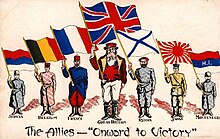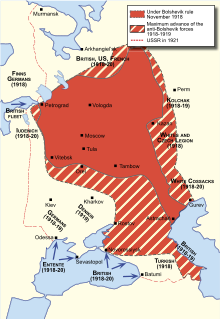User:Ted52/sandbox
Text
[edit | edit source]The Soviet Union and its leader, Joseph Stalin, take preeminent stage in narratives of the Second World War.
Russia at the turn of the 20th century
[edit | edit source]
The success of the Marxist-leaning communist revolutionaries of the old Russian Empire had been less than certain before 1914. The Russian emperor, known as the Tsar, sat at the helm of large-scale surveillance state that had effectively undermined what little democratic and pluralistic reforms there had been since the Revolution of 1905, that most painful episode of popular Russian resentment at the country's then-recent defeat in the Russo-Japanese War of 1904/05. The preconditions for a Marxist revolution in Russia were less than self-evident, as the rural and underdeveloped economy of the tsarist empire were very unfitting for the archetypal socialist focus on a well-organized urban working class. Additionally, communism with its ideas of secularism and state atheism were not exactly an appealing prospect to the deeply devout Russian population. And so, the Marxist movement that, until 1903, was organized in the Russian Social Democratic Labor Party and subsequently split into the "Bolsheviks" and the "Mensheviks" was at most a presence in Russia's few large urban centers such as Moscow or St Petersburg (later: Petrograd).
World war and civil war
[edit | edit source]
But the outbreak of the First World War (or "Great War") in 1914 changed everything. As the Russian Empire mobilized to protect its Slavic brother state and ally Serbia from the ambitions of the Austro-Hungarian Empire, and as the German Empire declared war on Russia to preempt Russian readiness for war, it was clear that the world would never be the same. Russia fought with millions of soldiers over the course of the years 1914 to 1917, undertaking several noteworthy campaigns and fighting several famous battles. In the end however, the economic and social hardships brought about my economic devastation through enemy occupation, the social strain of mass refugee movements, and the growing supply shortages of essential nutrition and basic products grew into large-scale popular resentment against tsarist rule and the continuation of the war. In March 1917, this boiled over in the February Revolution (so-called because of the mismatch between the Julian Calendar then in use in Russia versus the Gregorian Calendar used in the rest of the world). The February Revolution initially brought a government of liberals, moderate conservatives and moderate social reformers aiming to establish a constitutional republic. However, the new government of Alexander Kerensky fatefully decided to continue the pursuit of the war effort, and attempted to swing the luck on the Eastern Front of the First World War with its Kerensky Offensive of mid-1917. After the failure of this offensive, the Kerensky government had to face similar discontent with military failures that the tsar had. The Bolsheviks of Vladimir Ulyanov, known popularly by his nom de guerre as "Lenin", used this opportunity to launch an insurgency against the government in the major cities. Bolshevik forces subsequently took control of Moscow and Petrograd in what became known as the October Revolution (which, due to the mismatch between calendars, was in November 1917).

The Bolsheviks, also known as "Reds", faced several powerful enemies, both domestic and foreign. On one hand, they had not nearly brought all of Russia under their control. Instead, they came to control the central-western heartland of Russia somewhat quickly, whereas the remaining peripheries either rallied to the anti-communists, known as "Whites", or had already been occupied by Russia's enemies in war. This of course brings up the second powerful enemy the Bolsheviks still had to contend with: the Central Powers, i.e. the alliance of Germany, Austria-Hungary, Bulgaria and the Ottomans. The Germans and Austro-Hungarians stood deep inside the 1914 borders of Russia with hundreds of thousands of troops. The Bolsheviks, after several faulty approaches to negotiations had lost them even more of Russia's prewar boundaries, agreed in March 1918 to a humiliating peace treaty with the Central Powers; the Treaty of Brest-Litovsk was however never implemented due to the Central Powers' impending defeat at the hands of Russia's former allies, the Entente. Just these Entente, then, were the Bolsheviks' third major military and diplomatic challenger. Beginning in early 1918, several Entente powers (the United Kingdom, the United States, France, Japan, Greece, Serbia, Italy, Romania, as well as elements of several newly-emerged states or territories undergoing such statebuilding processes, such as Czechoslovakia or Estonia) landed troops in the various peripheries of the former Russian Empire. These troops were usually tasked with supporting the anti-Bolshevik White Army against the Bolshevik-controlled Red Army. Additionally, a fourth challenge was posed by unaligned forces in the civil war following their own ambitions, such as the ruralist agrarian Green Army, the anarchist Black Army, and numerous national independence movements, such as in Finland, Estonia, Latvia, Lithuania, and most notably in Poland.
The Russian Civil War was militarily decided in favor of the Bolsheviks by the latest by 1920/21, even though remnant holdouts of the White Army retained control of faraway corners of the former empire, such as the far eastern city of Vladivostok on the Pacific Ocean, until October 1922. Entente intervention in Russia also lasted years, and the last Japanese forces withdrew from the Russian mainland only in June 1922. The Japanese occupation of the northern half of the island of Sakhalin even continued until 1925.
Soviet leadership under Lenin
[edit | edit source]During this time, the newly-established Soviet Russia (which would become one of the founding states of the Union of Soviet Socialist Republics, the "Soviet Union", in late 1922) was crippled by the first of the three major famines in Soviet history. Between 1921 and 1922, millions starved to death in the southwestern reaches of the Soviet state. International aid was dispatched, and a mission overseen by later U.S. President Herbert Hoover helped with the distribution of aid in the affected areas.